“Global Operational Analytics Market to reach a market value of USD 26.4 Billion by 2031 growing at a CAGR of 13.7%”
The Global Operational Analytics Market size is expected to reach $26.4 billion by 2031, rising at a market growth of 13.7% CAGR during the forecast period.
The North America segment witnessed 36% revenue share in the operational analytics market in 2023. North American companies have been early adopters of these analytics to improve decision-making, streamline processes, and gain a competitive edge. Furthermore, innovation and the implementation of sophisticated analytics tools are expedited by the presence of significant technology companies and solution providers.
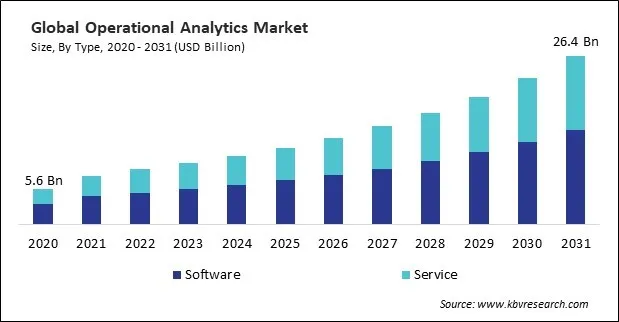
The major strategies followed by the market participants are Partnerships as the key developmental strategy to keep pace with the changing demands of end users. For instance, In June, 2024, IBM Corporation partnered with Telefónica Tech, a Spanish telecommunications company, to enhance AI, analytics, and data governance solutions in Spain. This partnership would develop an open, hybrid, multi-cloud platform, SHARK.X, featuring IBM's watsonx AI and Data platform. Moreover, In February, 2024, SAS Institute Inc. announced a partnership with Carahsoft, an IT company, to enhance SAS's analytics and AI solutions' accessibility to US government agencies. Under the partnership, Carahsoft would distribute SAS products through various government contracts, expanding SAS's public sector reach and supporting advanced data management and AI capabilities for improved decision-making and innovation.
Based on the Analysis presented in the KBV Cardinal matrix; Microsoft Corporation and Product Launches are the forerunners in the Operational Analytics Market. In June, 2023, Microsoft Corporation signed a partnership with Moody’s, a financial services company. The partnership aimed to develop advanced data, analytics, and risk solutions using Microsoft Azure OpenAI Service. Companies such as Amazon Web Services, Inc., Oracle Corporation and IBM Corporation are some of the key innovators in Operational Analytics Market.
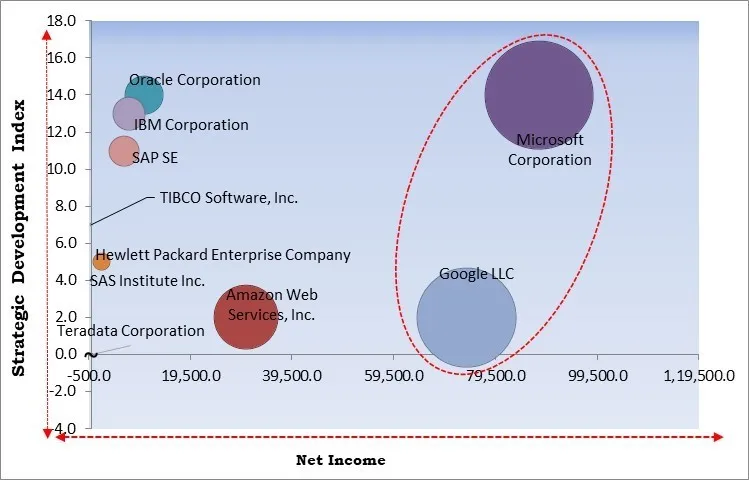
The rapid growth of IoT and Big Data generates unprecedented data from a vast network of sensors, machines, and equipment across various industries. IoT devices collect continuous data streams, capturing real-time insights into operations, from tracking assets in logistics to monitoring energy usage in smart buildings. This influx of data has created a demand for these analytics tools to process and analyze these extensive datasets, transforming them into actionable insights for better operational decision-making and efficiency. Thus, as the adoption of IoT devices continues to grow, so will the demand for these analytics solutions that can transform raw data into valuable insights.
Additionally, The increasing adoption of cloud technology is transforming the landscape of these analytics as organizations recognize the numerous advantages that cloud-based solutions bring to their data operations. It is estimated that global public cloud spending reached approximately $600 billion in 2023, a substantial increase from $490 billion in 2022. Therefore, the assistance of these analytics in a cloud environment is increasing their adoption.
However, Data breaches and cyber-attacks have increased significantly in recent years, exposing sensitive business and customer information. This rise in data breaches has made companies more cautious about data sharing, as they aim to avoid the risk of financial penalties, reputational damage, and loss of customer trust. Businesses now recognize that even a single data breach can have long-lasting consequences, impacting customer loyalty and the company's market position. Consequently, this hesitation to leverage data fully and the intricate compliance requirements are key factors that impede the rapid adoption and growth of this market.
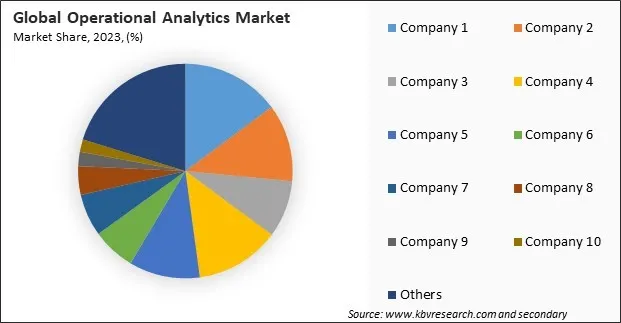
The leading players in the market are competing with diverse innovative offerings to remain competitive in the market. The above illustration shows the percentage of revenue shared by some of the leading companies in the market. The leading players of the market are adopting various strategies in order to cater demand coming from the different industries. The key developmental strategies in the market are Partnerships & Collaborations.


Based on type, the operational analytics market is bifurcated into software and service. The service segment procured 42% revenue share in this market in 2023. The service segment is driven by the need for specialized expertise to implement, integrate, and maintain these analytics solutions effectively. As analytics technologies become more sophisticated, organizations often require consulting, implementation, training, and support services to ensure they can leverage these tools to their full potential.
On the basis of business function, the operational analytics market is classified into information technology (IT), sales & marketing, finance, human resources (HR), and others. The sales & marketing segment recorded 24% revenue share in this market in 2023. The segment leverages these analytics to understand customer behavior, personalize marketing efforts, and optimize sales strategies. With consumer preferences shifting rapidly, sales and marketing teams use analytics to analyze purchasing patterns, customer feedback, and engagement metrics.
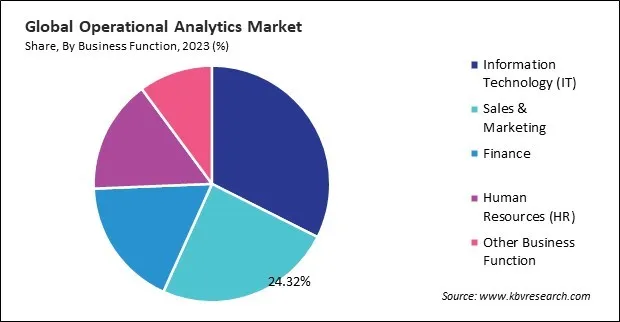
By application, the operational analytics market is divided into predictive asset maintenance, risk management, fraud detection, supply chain management, customer management, and others. The risk management segment garnered 19% revenue share in this market in 2023. The risk management segment is propelled by the increasing complexity and interconnectedness of business operations, which makes risk identification and mitigation a critical priority. These analytics enables organizations to monitor real-time risk indicators, analyze data from diverse sources, and predict potential threats before they impact the business.
On the basis of deployment model, the operational analytics market is bifurcated into cloud and on-premises. The on-premises segment garnered 37% revenue share in this market in 2023. On-premises deployments give organizations direct control over their data and infrastructure, ensuring compliance with stringent regulatory standards and internal policies. Although on-premises solutions necessitate a more substantial initial hardware investment and ongoing maintenance, they enable organizations to customize the configuration to their unique requirements and store data locally.
By industry vertical, the operational analytics market is divided into telecommunication, retail & consumer goods, manufacturing, government & defense, energy & utilities, healthcare, and others. The retail & consumer goods segment acquired 17% revenue share in this market in 2023. The retail & consumer goods segment is fueled by the need to understand consumer behavior, optimize inventory, and streamline supply chains. Retailers use these analytics to analyze purchasing patterns, forecast demand, and tailor marketing strategies.
Free Valuable Insights: Global Operational Analytics Market size to reach USD 26.4 Billion by 2031
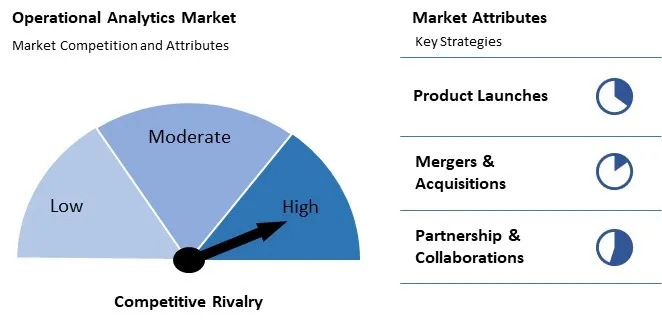
The Operational Analytics Market is dynamic, with smaller and mid-sized companies actively innovating to capture market share. Without top key players, competition intensifies among emerging vendors focusing on specialized solutions, cloud integration, and industry-specific analytics. Differentiation is largely driven by advanced data visualization, AI, and machine learning capabilities, enabling companies to offer tailored, cost-effective solutions that attract niche market segments.
Region-wise, the operational analytics market is analyzed across North America, Europe, Asia Pacific, and LAMEA. The Europe segment garnered 31% revenue share in this market in 2023. European organizations are adopting these analytics to meet stringent regulatory standards, especially in sectors like finance, healthcare, and manufacturing, where compliance is critical.
| Report Attribute | Details |
|---|---|
| Market size value in 2023 | USD 9.6 Billion |
| Market size forecast in 2031 | USD 26.4 Billion |
| Base Year | 2023 |
| Historical Period | 2020 to 2022 |
| Forecast Period | 2024 to 2031 |
| Revenue Growth Rate | CAGR of 13.7% from 2024 to 2031 |
| Number of Pages | 418 |
| Number of Tables | 683 |
| Report coverage | Market Trends, Revenue Estimation and Forecast, Segmentation Analysis, Regional and Country Breakdown, Competitive Landscape, Market Share Analysis, Porter’s 5 Forces Analysis, Company Profiling, Companies Strategic Developments, SWOT Analysis, Winning Imperatives |
| Segments covered | Type, Business Function, Application, Deployment Model, Industry Vertical, Region |
| Country scope |
|
| Companies Included | Microsoft Corporation, Oracle Corporation, SAS Institute Inc., Amazon Web Services, Inc. (Amazon.com, Inc.), Google LLC, Hewlett Packard Enterprise Company, IBM Corporation, SAP SE, Teradata Corporation, and TIBCO Software, Inc. (Vista Equity Partners Management, LLC) |
By Type
By Business Function
By Application
By Deployment Model
By Industry Vertical
By Geography
This Market size is expected to reach $26.4 billion by 2031.
Rising Demand For Real-Time Data are driving the Market in coming years, however, Data Privacy And Security Concerns restraints the growth of the Market.
Microsoft Corporation, Oracle Corporation, SAS Institute Inc., Amazon Web Services, Inc. (Amazon.com, Inc.), Google LLC, Hewlett Packard Enterprise Company, IBM Corporation, SAP SE, Teradata Corporation, and TIBCO Software, Inc. (Vista Equity Partners Management, LLC)
The expected CAGR of this Market is 13.7% from 2024 to 2031.
The Cloud segment led the maximum revenue in the Market by Deployment Model in 2023, thereby, achieving a market value of $16.1 billion by 2031.
The North America region dominated the Market by Region in 2023, and would continue to be a dominant market till 2031; thereby, achieving a market value of $8.9 billion by 2031.
Our team of dedicated experts can provide you with attractive expansion opportunities for your business.
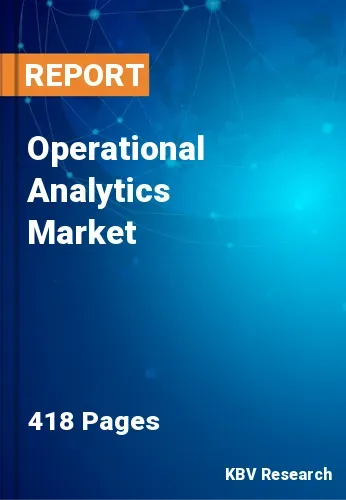
 Drivers
Drivers
 Restraints
Restraints
 Opportunities
Opportunities
 Challenges
Challenges
